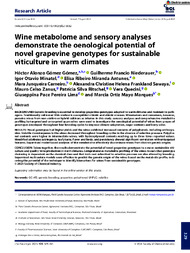Wine metabolome and sensory analysesdemonstrate the oenological potential ofnovel grapevine genotypes for sustainableviticulture in warm climates.
Wine metabolome and sensory analysesdemonstrate the oenological potential ofnovel grapevine genotypes for sustainableviticulture in warm climates.
Author(s): GÓMEZ, H. A. G.; NIEDERAUER, G. F.; MINATEL, I. O.; ANTUNES, E. R. M.; CARNEIRO, M. J.; SAWAYA, A. C. H. F.; ZANUS, M. C.; RITSCHEL, P. S.; QUECINI, V.; LIMA, G. P. P.; MARQUES, M. O. M.
Summary: Genetic breeding is essential to develop grapevine genotypes adapted to warm climates and resistant to path-ogens. Traditionally cultivated Vitis vinifera is susceptible to biotic and abiotic stresses. Winemakers and consumers, however,perceive wines from non-vinifera or hybrid cultivars as inferior. In this study, sensory analyses and comprehensive metabolitepro?ling by targeted and untargeted approaches were used to investigate the oenological potential of wines from grapes ofgenotypes developed throughout four breeding cycles to improve climate adaptation, sugar contents and berry color.
Publication year: 2024
Types of publication: Journal article
Unit: Embrapa Grape & Wine
Keywords: GC–MS, Genetic breeding, Grapevine, Polyphenol, UHPLC, Volatiles
Observation
Some of Embrapa's publications are published as ePub files. To read them, use or download one of the following free software options to your computer or mobile device. Android: Google Play Books; IOS: iBooks; Windows and Linux: Calibre.
Access other publications
Access the Agricultural Research Database (BDPA) to consult Embrapa's full library collection and records.
Visit Embrapa Bookstore to purchase books and other publications sold by Embrapa.

